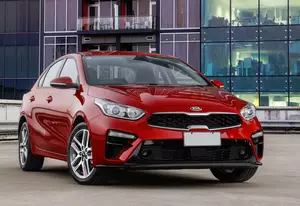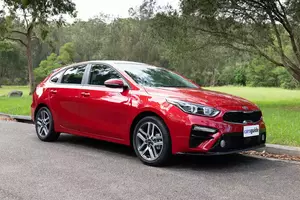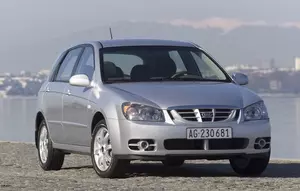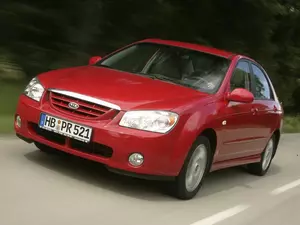
| Vehicle | Curb weight | Difference from world's smallest | Weight to power ratio | 0—60 mph acceleration ratio | Consumption ratio |
|---|---|---|---|---|---|
| 2.0 MPI |
1320 kg / 2911 lbs |
895 kg (1974 lbs) heavier | 9 kg to 1 hp | - |
178 kg/L (392 lbs/L) |
| GT 1.6 T-GDI |
1295 kg / 2855 lbs |
870 kg (1918 lbs) heavier | 6 kg to 1 hp | - |
190 kg/L (419 lbs/L) |
| Vehicle | 2.0 MPI |
|---|---|
| Curb weight |
1320 kg / 2911 lbs |
| Difference from world's smallest | 895 kg (895 lbs) heavier |
| Weight to power ratio | 9 kg to 1 hp |
| 0—60 mph acceleration ratio | - |
| Consumption ratio |
178 kg/L (392 lbs/L) |
| Vehicle | GT 1.6 T-GDI |
| Curb weight |
1295 kg / 2855 lbs |
| Difference from world's smallest | 870 kg (870 lbs) heavier |
| Weight to power ratio | 6 kg to 1 hp |
| 0—60 mph acceleration ratio | - |
| Consumption ratio |
190 kg/L (419 lbs/L) |

| Vehicle | Curb weight | Difference from world's smallest | Weight to power ratio | 0—60 mph acceleration ratio | Consumption ratio |
|---|---|---|---|---|---|
| 2.0 MPI |
1270 kg / 2800 lbs |
845 kg (1863 lbs) heavier | 8 kg to 1 hp | - |
172 kg/L (379 lbs/L) |
| GT 1.6 T-GDI |
1320 kg / 2911 lbs |
895 kg (1974 lbs) heavier | 6 kg to 1 hp | - |
194 kg/L (428 lbs/L) |
| Vehicle | 2.0 MPI |
|---|---|
| Curb weight |
1270 kg / 2800 lbs |
| Difference from world's smallest | 845 kg (845 lbs) heavier |
| Weight to power ratio | 8 kg to 1 hp |
| 0—60 mph acceleration ratio | - |
| Consumption ratio |
172 kg/L (379 lbs/L) |
| Vehicle | GT 1.6 T-GDI |
| Curb weight |
1320 kg / 2911 lbs |
| Difference from world's smallest | 895 kg (895 lbs) heavier |
| Weight to power ratio | 6 kg to 1 hp |
| 0—60 mph acceleration ratio | - |
| Consumption ratio |
194 kg/L (428 lbs/L) |

| Vehicle | Curb weight | Difference from world's smallest | Weight to power ratio | 0—60 mph acceleration ratio | Consumption ratio |
|---|---|---|---|---|---|
| 1.6 |
1220 kg / 2690 lbs |
795 kg (1753 lbs) heavier | 12 kg to 1 hp | 98 kg/s (216 lbs/s) |
156 kg/L (344 lbs/L) |
| 2.0 |
1276 kg / 2814 lbs |
851 kg (1877 lbs) heavier | 9 kg to 1 hp | 129 kg/s (284 lbs/s) |
154 kg/L (340 lbs/L) |
| 2.0 CRDi |
1324 kg / 2919 lbs |
899 kg (1982 lbs) heavier | 12 kg to 1 hp | 121 kg/s (267 lbs/s) |
221 kg/L (487 lbs/L) |
| 1.5 CRDi |
1290 kg / 2844 lbs |
865 kg (1907 lbs) heavier | 13 kg to 1 hp | 108 kg/s (238 lbs/s) |
263 kg/L (580 lbs/L) |
| Vehicle | 1.6 |
|---|---|
| Curb weight |
1220 kg / 2690 lbs |
| Difference from world's smallest | 795 kg (795 lbs) heavier |
| Weight to power ratio | 12 kg to 1 hp |
| 0—60 mph acceleration ratio | 98 kg/s (216 lbs/s) |
| Consumption ratio |
156 kg/L (344 lbs/L) |
| Vehicle | 2.0 |
| Curb weight |
1276 kg / 2814 lbs |
| Difference from world's smallest | 851 kg (851 lbs) heavier |
| Weight to power ratio | 9 kg to 1 hp |
| 0—60 mph acceleration ratio | 129 kg/s (284 lbs/s) |
| Consumption ratio |
154 kg/L (340 lbs/L) |
| Vehicle | 2.0 CRDi |
| Curb weight |
1324 kg / 2919 lbs |
| Difference from world's smallest | 899 kg (899 lbs) heavier |
| Weight to power ratio | 12 kg to 1 hp |
| 0—60 mph acceleration ratio | 121 kg/s (267 lbs/s) |
| Consumption ratio |
221 kg/L (487 lbs/L) |
| Vehicle | 1.5 CRDi |
| Curb weight |
1290 kg / 2844 lbs |
| Difference from world's smallest | 865 kg (865 lbs) heavier |
| Weight to power ratio | 13 kg to 1 hp |
| 0—60 mph acceleration ratio | 108 kg/s (238 lbs/s) |
| Consumption ratio |
263 kg/L (580 lbs/L) |

| Vehicle | Curb weight | Difference from world's smallest | Weight to power ratio | 0—60 mph acceleration ratio | Consumption ratio |
|---|---|---|---|---|---|
| 1.6 |
1178 kg / 2597 lbs |
753 kg (1660 lbs) heavier | 11 kg to 1 hp | 112 kg/s (247 lbs/s) |
173 kg/L (381 lbs/L) |
| 2.0 |
1225 kg / 2701 lbs |
800 kg (1764 lbs) heavier | 9 kg to 1 hp | 142 kg/s (313 lbs/s) |
163 kg/L (359 lbs/L) |
| 2.0 CRDi |
1299 kg / 2864 lbs |
874 kg (1927 lbs) heavier | 11 kg to 1 hp | 119 kg/s (262 lbs/s) |
217 kg/L (478 lbs/L) |
| 1.5 CRDi |
1270 kg / 2800 lbs |
845 kg (1863 lbs) heavier | 12 kg to 1 hp | 107 kg/s (236 lbs/s) |
259 kg/L (571 lbs/L) |
| Vehicle | 1.6 |
|---|---|
| Curb weight |
1178 kg / 2597 lbs |
| Difference from world's smallest | 753 kg (753 lbs) heavier |
| Weight to power ratio | 11 kg to 1 hp |
| 0—60 mph acceleration ratio | 112 kg/s (247 lbs/s) |
| Consumption ratio |
173 kg/L (381 lbs/L) |
| Vehicle | 2.0 |
| Curb weight |
1225 kg / 2701 lbs |
| Difference from world's smallest | 800 kg (800 lbs) heavier |
| Weight to power ratio | 9 kg to 1 hp |
| 0—60 mph acceleration ratio | 142 kg/s (313 lbs/s) |
| Consumption ratio |
163 kg/L (359 lbs/L) |
| Vehicle | 2.0 CRDi |
| Curb weight |
1299 kg / 2864 lbs |
| Difference from world's smallest | 874 kg (874 lbs) heavier |
| Weight to power ratio | 11 kg to 1 hp |
| 0—60 mph acceleration ratio | 119 kg/s (262 lbs/s) |
| Consumption ratio |
217 kg/L (478 lbs/L) |
| Vehicle | 1.5 CRDi |
| Curb weight |
1270 kg / 2800 lbs |
| Difference from world's smallest | 845 kg (845 lbs) heavier |
| Weight to power ratio | 12 kg to 1 hp |
| 0—60 mph acceleration ratio | 107 kg/s (236 lbs/s) |
| Consumption ratio |
259 kg/L (571 lbs/L) |